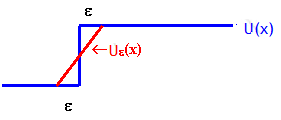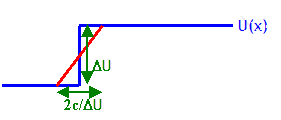

We study "square" potentials, or piece-wise constant potentials, because they may crudely approximate real potentials. Let us concentrate on one-dimensional "square" potentials. Assume U(x) = U = constant in certain regions of space. In such regions the time-independent Schroedinger equation, HΦ(x) = EΦ(x,) can be written as
∂2Φ(x)/∂x2 + (2m(E - U)/ħ2)Φ(x) = 0.
We find the eigenfunction of H by solving HΦE(x) = EΦE(x).
We can solve this equation in regions of piecewise constant potentials.
Let E > U:
Then ∂2Φ(x)/∂x2 + k2Φ(x) =
0, k2 = 2m(E - U)/ħ2.
The most general solution is Φ(x) = Aeikx
+ A'e-ikx, with A
and A’ complex constants.
Let E < U:
Then ∂2Φ(x)/∂x2 - ρ2Φ(x) =
0, ρ2 = 2m(U - E)/ħ2.
The most general solution is Φ(x) = Beiρx
+ B'e-iρx, with B and B’
complex constants.
Note: A solution exists in the classically forbidden region.
Let E = U:
∂2Φ(x)/∂x2 = 0
The most general solution is Φ(x) = Cx + C',
with C and C’ complex constants.

Approximate U(x) by Uε(x), which is
equal to U(x) everywhere except in a small region x1 ± ε, where it does not have the step but varies continuously.
We can write the Schroedinger equation as a difference equation,
∂Φε(x1 + ε)/∂x
+ ∂Φε(x1 - ε)/∂x
= (2m/ħ2)∫x1-εx1+ε (Uε(x) - E) Φ(x) dx
As ε --> 0, Uε(x)
remains finite, and therefore the
integral remains finite and decreases as ε decreases.
For ε = 0 the integral is zero. Therefore ∂Φε/∂x|ε-->0 is continuous.
At a finite step the boundary
conditions are that Φ(x) and ∂Φ(x)/∂x
are continuous.
(b) Assume U(x) does not remain finite on one side of the step.
Approximate U(x) by Uε(x) such that Uε(x)
has a step ∆U over a small interval 2ε = 2c/∆U.
As ε --> 0, ∆U
--> ∞, and ∫x1-εx1+ε (Uε(x) - E) Φ(x) dx
≈ Φ(x1)[c
- 2εE] --> cΦ(x1).

At an infinite step ∂Φε/∂x|ε-->0 is discontinuous, but it has a finite
discontinuity. Therefore Φ(x) remains
continuous as ε --> 0.
In a region of finite width ∆x, where |U| is
infinite, the wave function must be zero everywhere. Since the wave function
is
continuous, it also must be zero also at the boundary in the adjacent region.
If |U|
is infinite in a region with width ∆x = 0 (a δ-function,
for example), the
wave function can be finite there. It will have
the same value at the boundaries of the two adjacent regions and its derivative with
respect to x will be discontinuous.